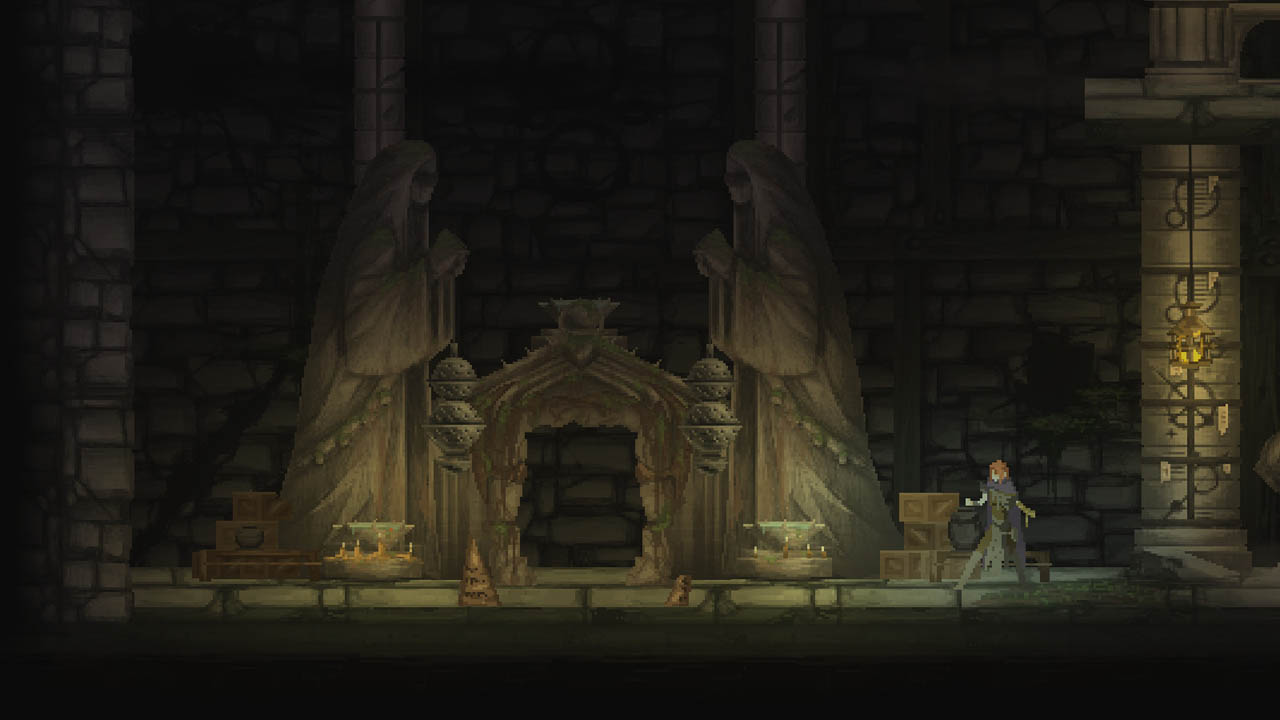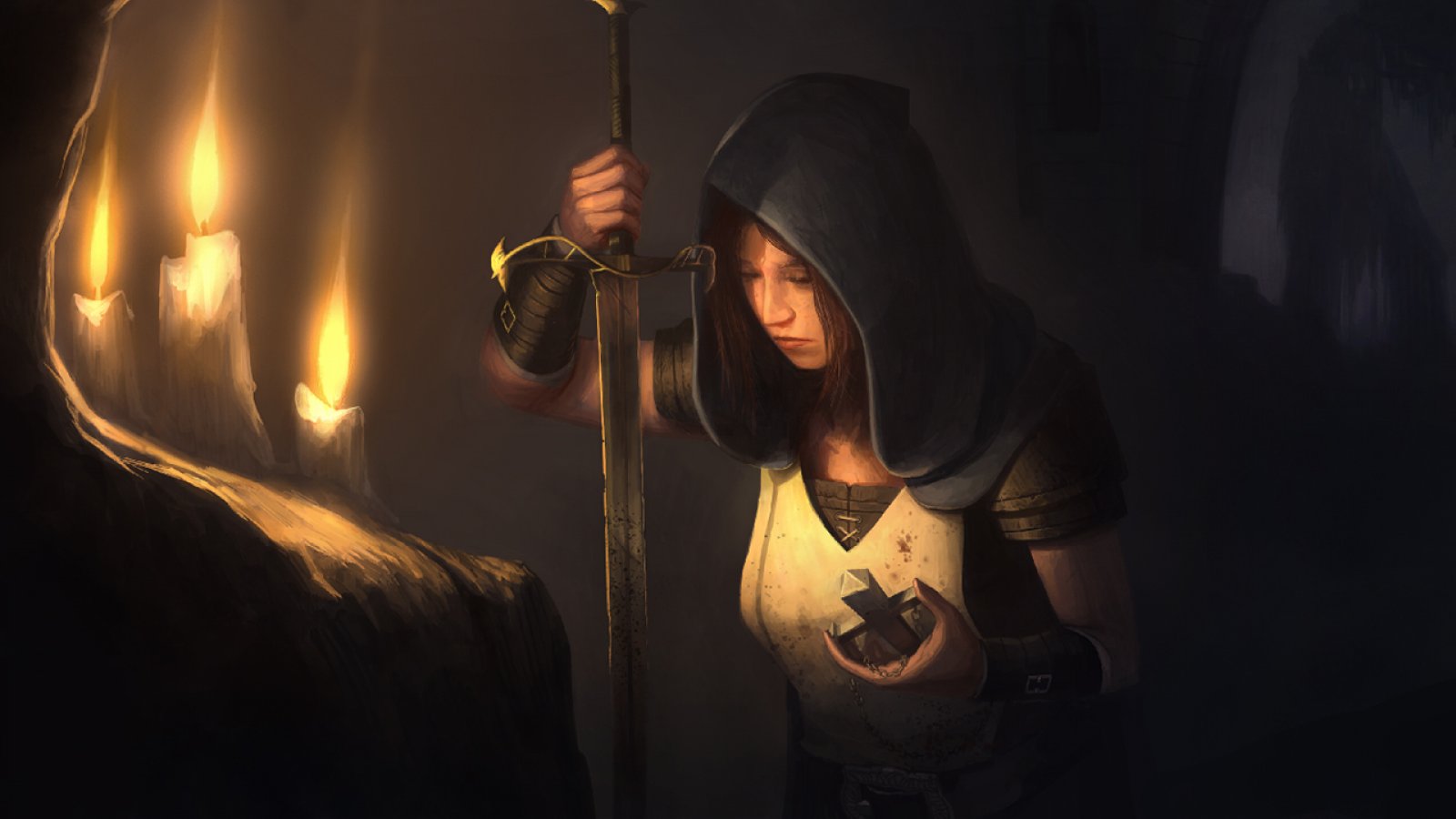Dark Devotion is a dark fantasy, 2D Dungeon-Crawling platformer, set in a medieval world based around religious dogma and the constant fear of being killed by forces beyond human understanding. Developer Hibernian Workshop brings a truly harrowing environment combined with an intense gaming experience making for an RPG-like experience not commonly seen.
The player controls an unnamed Templar tasked with infiltrating a fallen temple filled to the brim with terrifying monsters. They will collect weaponry and tools while leveling up and upgrading with the help of associates in the safe hubworld. There is much to explore and battle through the dungeons as the character waxes and weighs her loyalty to the god she worships.
THE WHISPERER IN DARKNESS

Unlike most 2D platformers, something that stands out about Dark Devotion is how slow and weighted the movement is. The Templar moves at a reasonable pace, but compared to most others in the genre, it is noticeably less free-wheeling. While at first this can be a bit difficult to manage, especially without a jump mechanic, this type of gameplay does make sense for such a mysterious and horror-based experience. Navigation of the game mostly forces the player downward, meaning decisions of where to enter must be handled methodically, adding to an already strategy-based equipment management system.
AT THE MOUNTAINS OF MADNESS
The game’s hub world can be an exceptionally useful tool when trying to strategize how to approach going back into the game after dying. This mostly consists of finding the right tools and weapons to fix what mistakes the player may have made the first time. A little added bonus, for those interested in that sort of thing, is how much lore and world-building can be found in the hub world. Not much of the game’s history can be found outside of it. Most of whatever can be found, narrative-wise outside of the hub is seen in little notes sprinkled about the game and, at most, are more letters from fallen templars than actual explanations of the story . While direction and instruction can feel a bit vague on how to properly prepare oneself for battle, it can be interesting to explore what the game has to offer plot-wise. The game seems to subscribe to the idea of leaving much of the detail out to add mystery to the overall experience, so it requires the player to make out on their own and learn more.
THE COLOR OUT OF SPACE

Pixel art is not the first artstyle one would think of for a dark, medieval fantasy story, but Devotion’s artwork is so well-thought out and detailed that it simply adds to the experience rather than feeling like it clashes with the tone. If anything, the art style harkens back to earlier series, such as Castlevania, in how it manages to create a striking medieval environment in spite of artwork distinctly based around computers. The game smartly bases its color scheme around blacks and browns, giving a lived-in feel chocked full of details that make one want to stop and appreciate the hard work of the environment builders, only to not have time to because of how often the player’s life is at stake.
FROM BEYOND
A testament to the detail in the design of the game is the look of the monsters and enemies. Ranging from humanoid to the animal, the monsters all manage to stand out and offer a challenge the more the temple is explored. An enjoyable aspect is the surprise bosses that can pop up at any moment. Initially, it can be shocking to have this happen the first time, but once it happens, it can be easier to prepare for it the next time. Something of a downside is that the combat essentially has the enemies be defeated in exactly the same way no matter how different they are from one another. Dodging and waiting is almost exclusively the way to beat them, though it’s almost entirely based on whether the right weapons and upgrade are equipped. Aside from that, however, the enemies are well thought out in design and gameplay, and still can be quite scary in spite of being two dimensional and pixelated.
THE UNNAMEABLE

The only noticeably frustrating element to the entire game is dying and returning to the hub world. At its core there’s nothing wrong with this type of mechanic; it’s often what one expects when playing a video game. Where the problem comes into play is that when the player dies, they are forced back into the hubworld with nothing they’ve collected and can only use whatever has been added to the blacksmith’s weapons he can forge. This makes going back into the world to explore a gamble; the player can only start at whatever portals they happen to find while exploring. Plus it creates an added anxiety when the game may leave a very useful weapon that the protagonist only keeps for as long as she stays alive. Something else worth noting is that even returning to the hubworld without dying doesn’t save the weapons collected, the protagonist is still left with nothing and needs to go collect weapons from the blacksmith. It’s not that this is necessarilybad game design, but no one outside of hardcore gamers is going to find this element fun. It can be discouraging to have accomplished so much in the game, only for it to have been taken away by being completely outclassed by an enemy the player wasn’t ready for.
The Verdict: Excellent
This is not a game for the faint of heart. It's a 2D hack and slash platformer solely hoping to capture the hardcore gamer market. Casual gamers will only wish to play this game out of curiosity rather than looking for an experience they are used to. With all that said, the hardcore market should have an incredibly enjoyable experience with the game’s focus on treacherous exploration, along with the unique look and world. While it might not have extremely in-depth management as much as most would like from an RPG, it has enough style and presentation to make it a worthwhile adventure for those looking for a unique take on Dark Fantasy video games.


